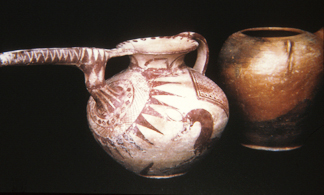
Burnished flasks, one with a pointed, bridged spout, Earthenware
Tepe Sialk, Central Iran, 1000 BCE
ART 198 - HISTORY OF WORLD CERAMICS
| These wheel thrown flasks were burnished, a process that involved rubbing the damp clay surface with a smooth object. Burnishing results in a tightening of the pores of the vessel's surface, increasing water retention in these low fired ceramics. The one on the left is painted with a design of a horse amidst geometric patterns. The unusual form of this piece suggests it was not made for ordinary domestic function, but rather for ceremonial use in a ritual ceremony involving the pouring of water as an offering. It was made on the 'fast wheel,' a wheel that maintained momentum rather than having to be constantly hand turned by the potter. Such a wheel allowed for greater symmetry in form. These pieces are from the area of modern day Central Iran, from a site known as Tepe Sialk. | Burnished flasks, one with a pointed, bridged spout, Earthenware Tepe Sialk, Central Iran, 1000 BCE |
|
|